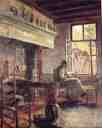 |
Jan De Cooman has painted some twenty Flemish farm kitchens. Our Flemish farmer interiors! There is a magical mystery in those wide, dim spaces. Everything is peaceful, hazy and quiet. A mysterious silence buzzes about all the simple life things. The light flows wonderfully intimately through the shiny windows and throws lusty, gold-vibrating spots on the blue floor pavements. Unusually delicate shades, full of fine contrasts vibrate against the dark ceiling, where dusk strikes the beams, in the bright glare on the edge of the tin patches above the mantelpiece, in the pale tone of rush chairs, in the gleaming of the brass stove. The whole atmosphere vibrates with clear peace. The people are absorbed into it, become one with the deep peace which encapsulates all things, and carry the inner harmony of the living room into their being and in their pastimes. A farmer’s kitchen has its own atmosphere, its light, its peculiar color and smell, it is full of poetry.
How did the artist display that intimacy, that pure closeness and visual beauty?
The interiors of Jan De Cooman run over two periods: a dozen were painted in the years 1914 to 1921 and the other ten in the course of the years 1930 to 1935. The difference of presentation, of insight and of feeling is particularly striking and somewhat disappointing. In the first ten, the pictorial element dominates: the harmonic color values determine their beauty and feeling. In the second period, the entire attention is devoted to the graphic accuracy of the composition, to the true-to-life reproduction: the impulsive color wizard gives way to the consideration to carefully justify the subject down to the smallest detail.
Most of the interiors from the earliest period are spread abroad. In two of the paintings from that time the same subject is treated: a farmhouse kitchen, seen from an open door, in the foreground the unexposed frame, indivisibly interwoven in the atmosphere, the open door and as a central point the view of the inner house, open-flowering in the brightness of daylight.
These are festively painted scenes! In the dark frame the dull shine of deep gray and blue tones has a special charm. The open door, dark brown, falls heavily and heavily in the muted symphony of the depth. From that unity a wonderful harmony arises, delicate and fragile, like a soft shade against the light, which glows warmly in the inner room.
The interior, seen through the open door, is treated differently in both fabrics. In one, a little trickle seeps from a window corner, the objects in the mysterious veil of indecision and melodiously flows into the general range of dullness. In the second painting the light, white and warm, penetrates into the room and spins around the objects, the golden glory of a splendid garment of brocade.
In these two paintings a purebred painter is working, who creates a magical world over the sober observation, in which the light reigns in his pure and complete omnipotence. The mood of the artist, who experiences the world and his youth as a delight, crystallizes in that fragile splendor. The light, muted or dazzling glow, expresses the soul of the artist, who in youthful ecstasy expresses the height of his life.
In these documents it becomes clear to us that Jan De Cooman, in the earliest years of becoming aware of himself, first and foremost became a painter and not a graphic artist. He developed a pictorial vision, as we rarely find it with a young man of barely twenty years.
Color and tone have something awesome, something monumental, and his visual power does nothing on purpose and is not yet affected by that conventional way of expression from later times.
What a promise these paintings were making, when we see how this was done, without calculation, spontaneously faded out, without details … only light twinkles, harmonious tingling, extremely sensitive and with that classic clarity which we love so much from Jan De Cooman!
In his second series Jan De Cooman shows us his farm kitchens as a folkloristic curiosity with a friendly hint: “Just see what it looks like among those good people!”. Indeed, we can view those old things with fascinating interest. It strikes us how well the brown wheat bread smells and how friendly the old patches and pots shine and how regularly that copper garland in the old watch ticks away the time.
In his interiors Jan De Cooman reveals himself as a sharply dissecting technician and at the same time as a sensitive artist and a delicate person, an artist, who knows how to capture the intuitive power in his essence in an animated content and of himself the power of the drama to move the viewer permanently. |